1994 BUICK REGAL service
[x] Cancel search: servicePage 242 of 308
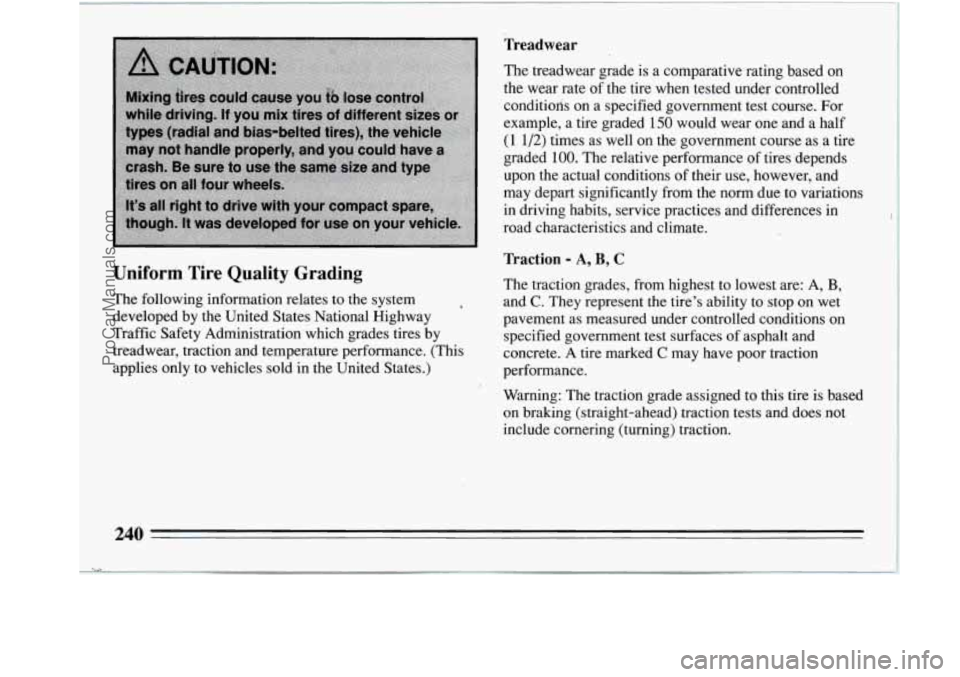
Uniform Tire Quality Grading
The following infortnation relates to the system
developed by the United States National Highway
Traffic Safety Administration which grades tires by
tfeadwear, traction and temperature performance. (This
applies only to vehicles sold in the United States.)
Treadwear
The treadwear grade is a comparative rating based on
the wear rate
of the tire when tested under controlled
conditiolis on a specified government test course. For
example, a tire graded
150 would wear one and a half
(1 1/2) times as well on the government course as a tire
graded
100. The relative performance of tires depends
upon the actual conditions
of their use, however, and
may depart significantly
from the norm due to variations
in driving habits, service practices and differences in
road characteristics and climate.
Traction - A, B, C
The traction grades, ffom highest to lowest are: A, B,
and C. They represent the tire's ability to stop on .wet
pavement as measured under controlled conditions on
specified government test surfaces of asphalt and
concrete.
A tire marked C may have poor traction
performance.
Warning: The traction grade assigned to this tire .is based
on braking (straight-ahead) traction tests and does not
include cornering (turning) traction.
240
ProCarManuals.com
Page 252 of 308
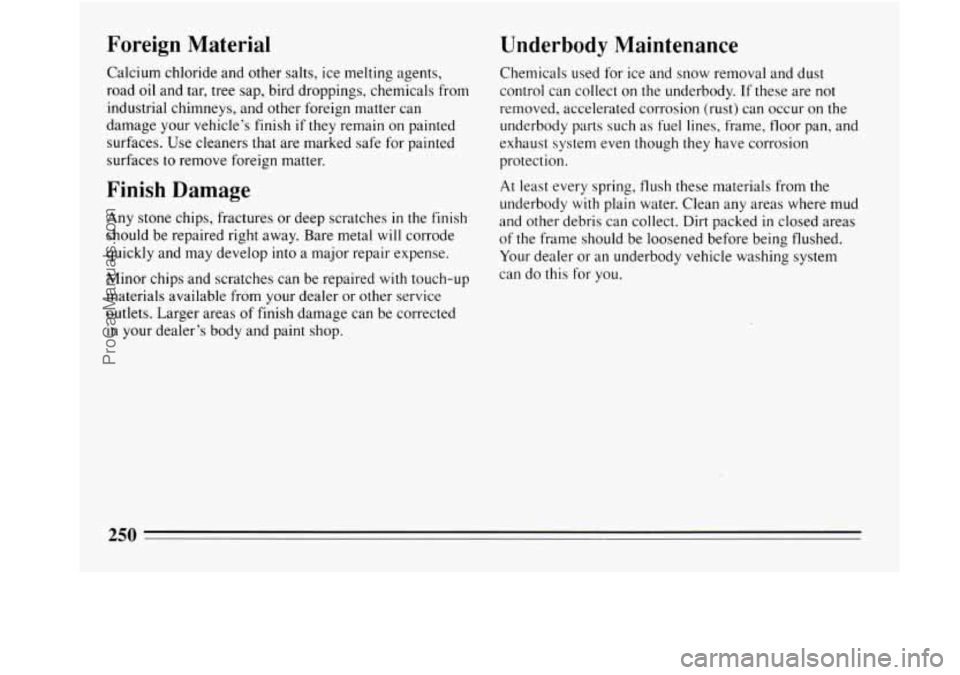
Foreign Material
Calcium chloride and other salts, ice melting agents,
road oil and tar, tree sap, bird droppings, chemicals from
industrial chimneys, and other foreign matter can
damage your vehicle’s finish if they remain on painted
surfaces. Use cleaners that are marked safe for painted
surfaces to remove foreign matter.
Finish Damage
Any stone chips, fractures or deep scratches in the finish
should be repaired right away. Bare metal
will corrode
quickly and may develop
into a major repair expense.
Minor chips and scratches can be repaired
with touch-up
materials available from your dealer or other service
outlets. Larger areas of finish damage can be corrected
in your dealer’s body and paint shop.
Underbody Maintenance
Chemicals used for ice and snow removal and dust
control can collect on the underbody. If these are not
removed, accelerated corrosion (rust) can occur on the
underbody parts such as fuel lines, frame, floor pan, and
exhaust system even though they have corrosion
protection.
At least every spring, flush these materials from the
underbody
with plain water. Clean any areas where mud
and other debris can collect. Dirt packed
in closed areas
of the frame should be loosened before being flushed.
Your dealer or an underbody vehicle washing system
can do this for you.
ProCarManuals.com
Page 255 of 308

Vehicle Identification Number (VIN)
Ip1“l SAMPLE4UXRM072675
ENGINE 44 f ASSEMBLY
CODE MODEL YEAR PLANT
This is the legal identifier for your Buick. It appears on
a plate
in the front corner of the instrument panel, on the
driver’s side.
You can see it if you look through the
windshield from outside your vehicle. The VIN also
appears on the Vehicle Certification and Service Parts
labels and the certificates of
title and registration.
Engine Identification
The eighth character in your VIN is the engine code.
This code will help
you identify your engine,
specifications, and replacement parts.
Service Parts Identification Label
You’ll find this label on the deck lid. It’s very helpful if
you ever need to order parts. On this label is:
your VIN,
the model designation,
paint information, and
a list of all production options and special equipment.
Be sure that this label is not removed from the vehicle.
Add-on Electrical Equipment
NOTICE:
Don’t add anything electrical to your Buick unless
you check with your dealer first. Some electrical equipment can damage your vehicle and the
damage wouldn’t be covered by your warranty.
Some add-on electrical equipment can keep other
components from working as they should.
Your vehicle has an air bag system. before attempting to
add anything electrical to your Buick, see “Servicing
Your Air Bag-Equipped Buick”
in the Index.
253
ProCarManuals.com
Page 265 of 308
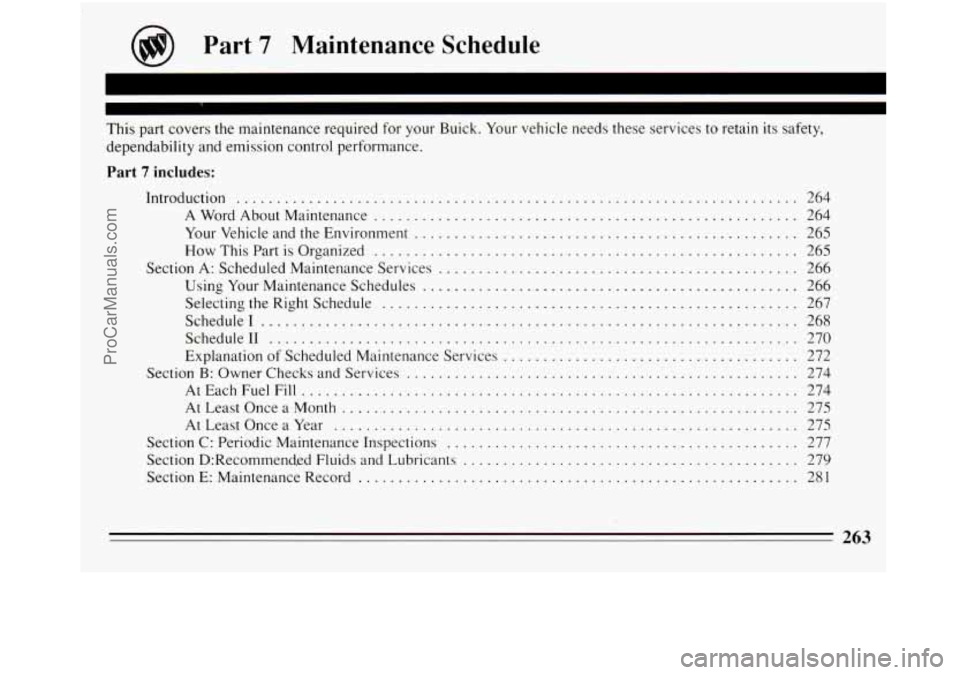
Part 7 Maintenance Schedule
This part covers the maintenance required for your Buick . Your vehicle needs these services to retain its safety.
dependability and emission control performance
.
Part 7 includes:
Introduction ......................................... ......... ................ 264
A Word About Maintenance ..................................................... 264
Your Vehicle and the Environment
................................................ 265
How This Part is Organized ..................................................... 265
Section A: Scheduled Maintenance Services
............................................. 266
Using Your Maintenance Schedules
............................................... 266
Selecting the Right Schedule
.................................................... 267
Schedule1
................................................................... 268
Schedule11
.................................................................. 270
Explanation
of Scheduled Maintenance Services ..................................... 272
Section
B: Owner Checks and Services ................................................. 274
AtEachFuelFill .............................................................. 274
At Least Once
a Month ......................................................... 275
AtLeastOnceaYear .......................................................... 275
Section
C: Periodic Maintenance Inspections ............................................ 277
Section D:Recommendgd Fluids
and Lubricants .......................................... 279
Section E: Maintenance Record ....................................................... 281
263
ProCarManuals.com
Page 267 of 308

Your Vehicle and the Environment
Proper vehicle maintenance not only helps to keep your
vehicle
in good working condition, but also helps the
environment. All recommended maintenance procedures
are important. Improper vehicle maintenance or the
removal
of important components can sigHificantly
affect the quality
of the air we breathe. Improper fluid
levels or
even the wrong tire inflation can increase the
level of emissions from your vehicle.
To help protect
our environment, and
to help keep your vehicle in good
condition, please maintain your vehicle properly.
How This Part is Organized
The remainder of this part is divided into five sections:
“Section
A: Scheduled Maintenance Services” shows
what to have done and how often. Some of these
services can be complex,
so unless you are technically
qualified and have
the necessary equipment, you should
let your dealer’s service department or another qualified
service center do these jobs. If you
are skilled enough to do some work on your
vehicle,
you will probably want to get the service
information
GM publishes. You will find a list of
publications and how to get them in this manual. See
“Service Publications”
in the Index.
“Section B: Owner Checks and Services” tells you what
should be checked whenever you stop for fuel.
It also
explains what you can easily do to help keep your
vehicle
in good condition.
“Section C: Periodic Maintenance Inspections” explains important inspections that your Buick dealer’s service
department or another qualified service center should perform.
265
ProCarManuals.com
Page 268 of 308
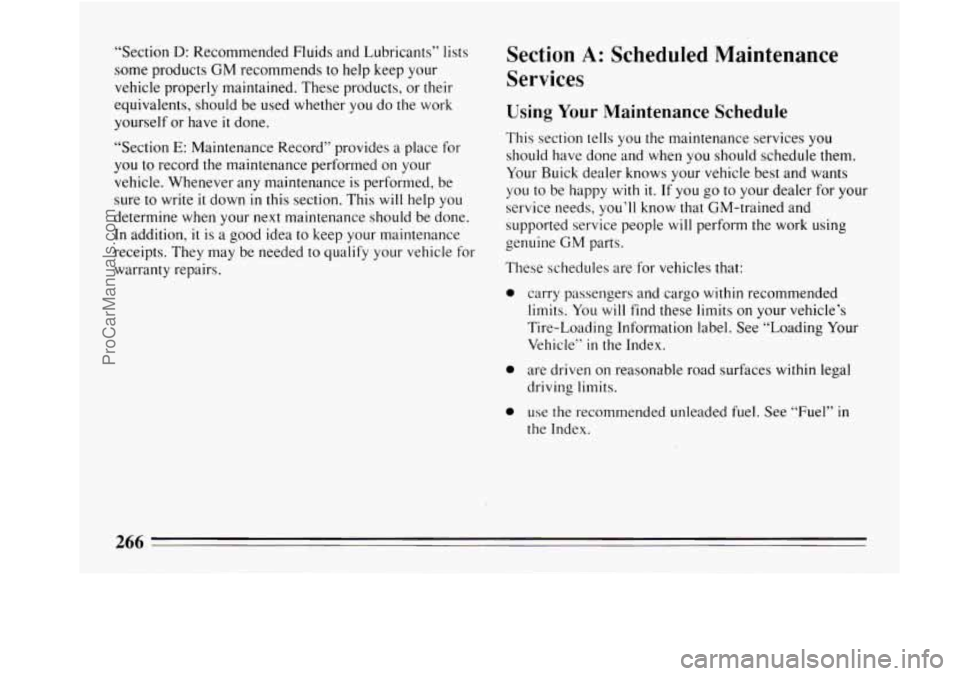
“Section D: Recommended Fluids and Lubricants” lists
some products
GM recommends to help keep your
vehicle properly maintained. These products, or their
equivalents, should be used whether you do the work
yourself or have
it done.
“Section
E: Maintenance Record” provides a place for
you to record the maintenance performed on your
vehicle. Whenever any maintenance is performed, be
sure to write
it down in this section. This will help you
determine
when your next maintenance should be done.
In addition,
it is a good idea to keep your maintenance
receipts. They may be needed to qualify your vehicle for
warranty repairs.
Section A: Scheduled Maintenance
Services
Using Your Maintenance Schedule
This section tells you the maintenance services you
should have done and when you should schedule them.
Your Buick dealer knows your vehicle best and wants
you to be happy with it. If you
go to your dealer for your
service needs, you’ll know that GM-trained and
supported service people
will perform the work using
genuine
GM parts.
These schedules are for vehicles that:
0
0
0
carry passengers and cargo within recommended
limits. You
will find these limits on your vehicle’s
Tire-Loading Information label. See “Loading Your
Vehicle”
in the Index.
are driven on reasonable road surfaces within legal
driving limits.
use the recommended unleaded fuel. See “Fuel”
in
the Index.
266
ProCarManuals.com
Page 270 of 308
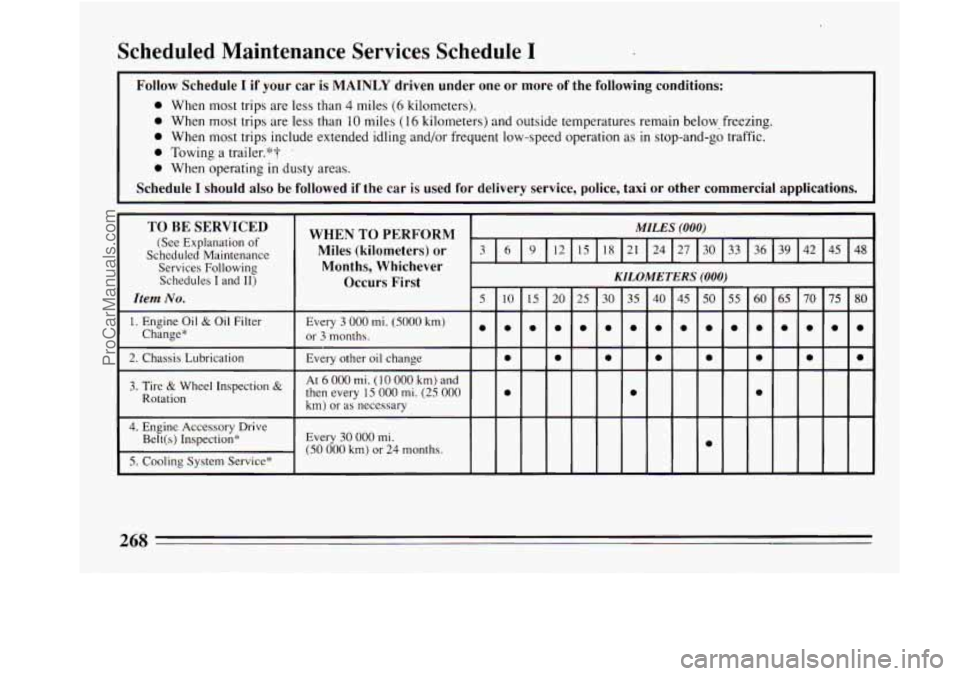
Scheduled Maintenance Services Schedule I
Follow Schedule I if your car is MAINLY driven under one or more of the following conditions:
0 When most trips are less than 4 miles (6 kilometers).
0 When most trips are less than 10 miles (16 kilometers) and outside temperatures remain below freezing.
0 When most trips include extended idling and/or frequent low-speed operation as in stop-and-go traffic.
0 Towing a trailer."? '
0 When operating in dusty areas.
I
Schedule I should also be followed if the car is used for delivery service, police, taxi or other commercial applications.
TO BE SERVICED
(See Explanation of
Scheduled Maintenance
Services Following Schedules
I and 11)
Item No.
1. Engine Oil & Oil Filter
Change"
2. Chassis Lubrication
3. Tire & Wheel Inspection &
Rotation
4. Engine Accessory Drive
Belt(s) Inspection*
5. Cooling System Service*
268
ProCarManuals.com
Page 271 of 308

I I
TO BE SERVICED
(See Explanation of
Scheduled Maintenance
Services Following
Schedules
I and 11)
WHEN TO PERFORM
Miles (kilometers) or
Months, Whichever
15 30 33 36 39 42 45 48 12 9 6 3
Occurs First
MILES (000)
KILOMETERS (000)
45 50
a
0
a
The services shown in this schedule up to 48 000 miles (80 000 km) should be performed after 48 000 miles at the
same intervals.
* An Emission Control Service.
i‘ The U.S. Environmental Protection Agency has determined that the failure to perform this maintenance item will not nullify the enlission warranty or limit recall liability prior to the completion of vehicle useful life. General Motors. however, urges that $11 recommended maintenance services be performed at the indicated i\
ntervals and the
maintenance be recorded in “Section E:Maintenance Record”.
ProCarManuals.com